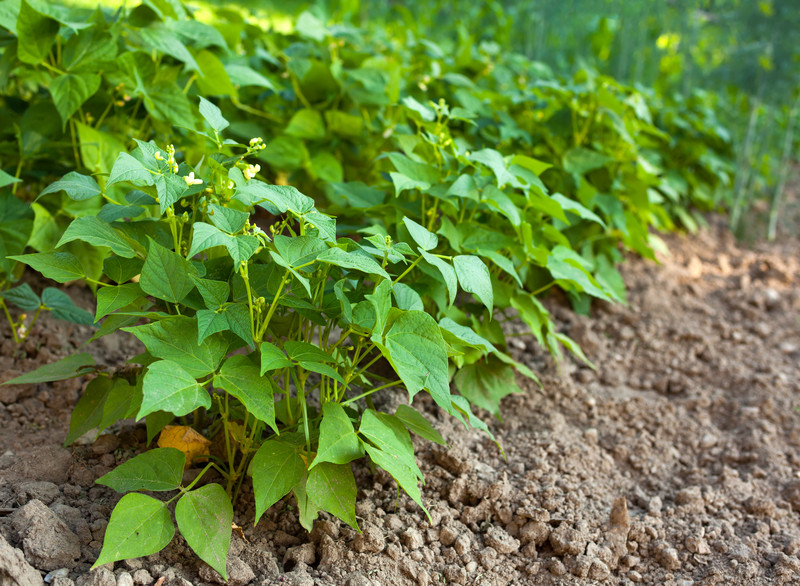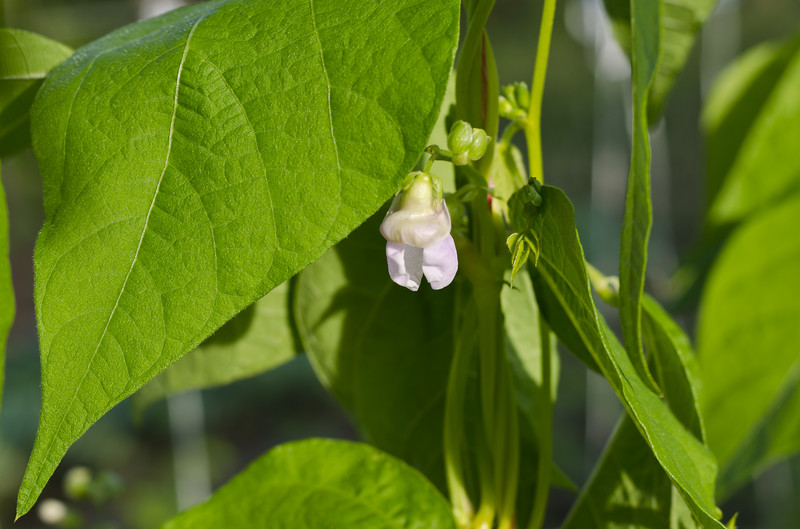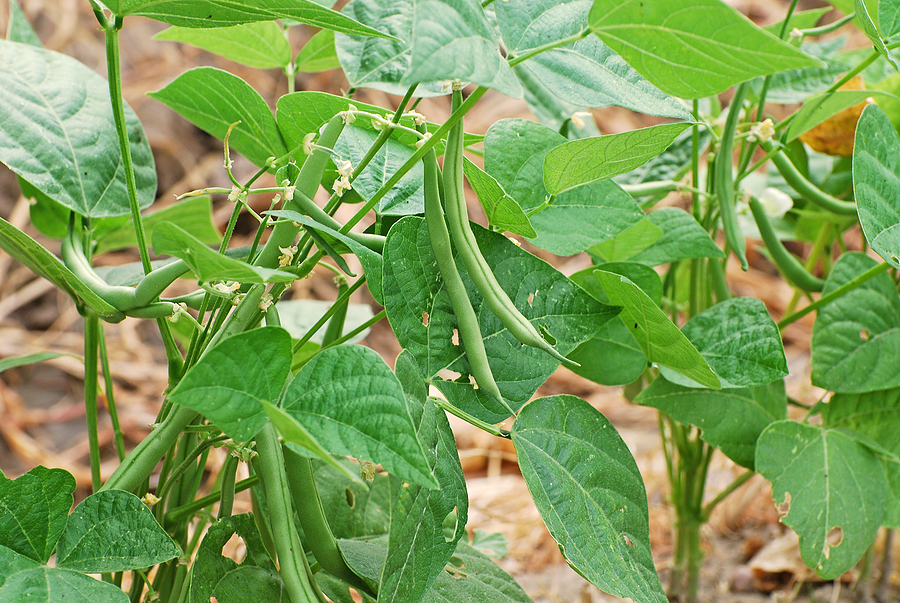Beans: garden beans–including pole, bush, and shell–lima beans, mung beans, scarlet runner beans, asparagus beans, and southern peas (which are not beans but share similar cultural requirements). All of these crops share similar problems.
Here is a list of common bean problems and possible causes and cures. For more on vegetable garden pests and diseases see the Pest Problem Solver and the Disease Problem Solver in the Index.
Good Products for Growing Beans at Amazon:
- Garden Safe Snail and Slug Bait
- Bonide Sulfur Fungicide
- Monterey BT Caterpillar Killer
- Neem Bliss 100-% Cold Pressed Neem Oil
- Safer Brand Insect Killing Soap
- PyGanic Botanical Insecticide
Bean problems: possible causes and cures:

Seed and seedling problems
Seedlings fail to emerge.
Several possible causes: (1) Beans are a warm weather crop and seed may rot in soil less than 50° to 60° F. Delay planting until the soil has warmed; (2) Soil is heavy or crusted; seedlings may not be able to push through. Add aged compost to the planting bed; cover the seed with light compost mulch; (3) Seed was sown too deep or not deep enough. Beans planted in spring 2 inches deep or more may rot and fail to germinate. Beans planted at the end of spring or in summer may dry out and die if sown less than 1 inch deep. Plant beans about 1 inch deep in early spring; 2 inches deep later in the season.
Seedlings are sheared or cut at the soil level, wilt, and fall over.
Cutworms are gray grubs curled in the soil at the base of plants. Keep the garden clean of debris and plant residue. Keep the garden weed-free. Use cardboard collars around seedlings.
Seedlings are deformed or have no growing tips or leaves when they emerge.
Seed corn maggots are the small yellowish-white larvae of small gray flies. Keep the garden clean. Cultivate to expose the larvae and disturb the life cycle. Replant when the weather is warmer.
Seeds rot or seedlings collapse with dark water-soaked stems as soon as they appear.
Damping off is a fungus that lives in the soil, particularly where humidity is high. Do not plant in cold, moist soil. Make sure the soil is well drained.
Seedlings are stunted and never recover.
Cold soil and weather can weaken seedlings that do emerge too early. The soil temperature is likely below 60°F. Pull up the seedlings, warm the soil with black or clear plastic, and sow new seeds.
Seedlings and plants stunted; leaves yellowed and distorted.
Thrips are tan to black bugs that look like slivers of wood; Thrips feed on plants, rasping plant tissue. Seedlings are most affected. Plants will outgrow and recover from thrip attack.

Leaf problems
Tiny shot holes in the leaves of seedlings.
Flea beetles are tiny bronze or black beetles a sixteenth of an inch long. They eat small holes in the leaves of seedlings and small transplants. The larvae feed on the roots of germinating plants. Spread diatomaceous earth around seedlings. Cultivate often to disrupt the life cycle. Keep the garden clean.
Large irregularly shaped holes in leaves.
Bean leaf beetles are reddish to yellowish-orange about ¼-inch long with black spots on their backs and black margins on their front wings. Larvae will bore into roots. Handpick and destroy. Keep the garden clean. Cultivate to 6 inches in spring to destroy larvae and disrupt the life cycle. Exclude beetles with floating row covers.
Holes chewed in leaves, leaves skeletonized.
The spotted cucumber beetle is greenish, yellowish, ¼ inch (7mm) long with black spots and a black head. The striped cucumber beetle has wide black stripes on the wing covers. Handpick; mulch around plants; plant resistant varieties; dust with wood ashes.
Leaves are skeletonized.
Mexican bean beetle or Japanese beetle: Mexican bean beetle is a coppery-yellow bug the size and shape of a ladybug, about ¼-inch long with 16 black spots on winger covers. The larva is yellow with a long black-tipped spine. Beetles and larvae feed on the undersides of bean leaves. Egg masses are on the undersides of the leaves. Japanese beetles have iridescent green wing covers. Handpick and crush beetles and eggs. Plant late in cool regions and early in warm regions to avoid first egg laying. Exclude beetles from the garden with row covers. Coat plants with kaolin clay to discourage feed and egg-laying.
Leaves curl under and become deformed; shiny, sticky honeydew on leaf surfaces; black sooty mold may follow.
Aphids are tiny, oval, and yellowish to greenish pear-shaped insects that colonize the undersides of leaves. They suck plant juices and leave behind sticky excrement called honeydew. Use insecticidal soap. Ants farm aphids; control ants with a sticky barrier.
Leaves yellow; shiny sticky honeydew on the leaf surface.
Clouds of tiny white insects fly when the plant is disturbed. Whiteflies congregate on the undersides of leaves and fly up when disturbed. Remove infested leaves and the whole plant if the infestation is serious. Introduce beneficial insects into the garden. Whiteflies do not reduce yields.
White speckling or stippling on the upper leaf surface, tip, and margin appear scorched; white cast insect skins on the underside of leaves.
Leafhoppers are green, brown, or yellow bugs to ⅓-inch long with wedge-shaped wings. They jump sideways and suck the juices from plants. Use insecticidal soap. Cover plants with a floating row cover to exclude bugs; spray with insecticidal soap.
Top of leaves speckled or stippled white or yellow; fine gray webbing on undersides of leaves; leaves eventually turn pale green, yellow then brown.
Spider mites suck plant juices causing stippling. Keep plants well watered. Wash mites off leaves with a spray of water or use insecticidal soap or rotenone. Ladybugs and lacewings eat mites.

Leaf, stem, and pod problems
Gray mold or white mold grows on leaves, stems, or pods; rotting follows.
Gray mold or white mold or mycelium is caused by a fungus prevalent in warm weather. White mold will also result in water-soaked leaves and rot. Increase space between plants to improve air circulation. Rotate crops. Remove plant debris and broadleaf weeds.
White, powdery spots on leaves and pods.
Powdery mildew or downy mildew (usually only on lima beans) is caused by fungal spores. Spores germinate on dry plant surfaces when the humidity is high; spores do not germinate on wet leaves. Common in late summer or fall but does not result in the loss of the plant. Avoid water stress. Prune away infected leaves and pods. Keep the garden free of plant debris. Rotate crops.
Water-soaked spots on the leaves, stems, and pods become covered with cottony mold.
Bacterial wilt clogs the circulatory system of plants. It is spread by cucumber beetles and is seen often where the soil stays moist. Remove and destroy infected plants before the disease spreads. Make sure the soil is well drained. Control cucumber beetles with rotenone or sabadilla. Rotate crops.
Small brown spots on leaves are surrounded by yellow halos; water-soaked spots on the pod.
Bacterial blight is most severe where humidity is high for a long period. Avoid overhead watering. There is no cure. Remove infected plants. Rotate crops.
Round to angular streaks on leaves, reddish brown to black; sunken water-soaked areas on pods; pods shrivel and become watery.
Anthracnose is a fungal disease. Remove and discard infected plants. Avoid working in the garden when it is wet which can result in the spread of spores. Keep tools clean.
Leaves yellow; plants wilt and appear weak; sunken, red oval spots at the base of the stem; roots have red spots or streaks; plants turn brown and decay.
Rhizoctonia or Fusarium root or stem rot is a fungal disease that favors warm soil. Remove infected plants and plant debris that harbor fungus. Rotate crops. Be sure transplants are not diseased. Rotate crops regularly. Solarize the soil in late spring or summer.
Rusty-orange to reddish brown or black blisters or pustules on stems and leaves.
Rust is a fungus disease. It is most prevalent in humid regions. Prune away infected leaves or plants. Plant disease-resistant varieties. Water evenly; avoid overhead watering.
Leaves pucker downward, veins turn purple; plant becomes stunted; pods are small and yield is low.
The curly top virus is spread by leafhoppers. Once the virus hits lift and throw away the plants. Control leafhoppers. Remove and destroy diseased plants when first noticed.
Mottled light and dark green patterns on leaves; leaves are distorted and may become brittle and easily broken; plants are stunted.
Mosaic virus has no cure; it is spread from plant to plant by aphids and leafhoppers. There is no cure for the virus. Plant disease-resistant varieties. Remove diseased plants. Remove broadleaf weeds that serve as virus reservoirs. Infected plants can produce edible fruit but the size and yield are reduced
Leaves turn yellow and then brown from the bottom up; the plant loses vigor; plants appear stunted; roots appear to have knots or beads.
Nematodes or wireworms: (1) Root-knot nematodes are microscopic worm-like animals that live in the film of water that coat soil particles; some are pests, and some are not. Root-knot nematodes feed in the roots and stunt plant growth; they are most common in sandy soils. Rotate crops. Solarize the soil with clear plastic in mid-summer. (2) Wireworms are the soil-dwelling larvae of click beetles; they look like wire-jointed worms. Check the soil before planting; flood the soil if wireworms are present. Remove infested plants and surrounding soil.
Leaves wilt; plants appear stunted.
Soil may be too wet or too dry or the soil may not be fertile. Add aged compost or organic matter to the soil to improve drainage and to improve soil nutrition. Give plants even, regular water, but do not over-water. Mulch in summer.

Flower problems
Plants flower, but blossoms drop.
There are several possible reasons: (1) Night temperatures are too low, less than 55°F (13°C): use a hormone spray to improve fruit set during low temperatures and keep soil evenly moist. (2) Day temperatures are too high, greater than 90°F (32°C): there is no solution, temperatures must drop. Also, the weather may be windy. (3) Smog during the blossoming period: tap on blossoms 3 times a week when flowers are open to assist pollination. (4) Too much nitrogen in the soil: feed plants properly; (5) too much shade: plant beans in full sun. (6) Early blossoming, then drop: don’t plant too early, early blossoms will not set fruit. (7) Variety planted is not adapted to your region: get regional suggestions from a garden center or the cooperative extension. Avoid planting Blue Lake, Kentucky Wonder, and pole lima beans which are especially susceptible to blossom pod drop. Plant quick-maturing varieties.
Early flowers don’t set fruit.
Several possible reasons: (1) Soil is not fertile; added aged compost to the planting bed and turn it under to about 6 inches. (2) Soil is heavy in nitrogen; nitrogen results in foliage growth, not fruit growth. Add aged compost to the planting bed–compost is equivalent to adding a complete, even fertilizer such as 10-10-10. (3) Pods have not been harvested regularly. Mature pods left on the vine will reduce new pod developments.
Buds and flowers drop; maturing beans pitted and blemished.
Lygus bugs are green, straw yellow, or brain with a green triangle on the back. They have piercing-sucking mouthparts and feed on leaves and pods. Keep the garden free of weeds where they live. Handpick and destroy. A few can be tolerated.

Pod problems
Pods begin to develop and then shrivel.
A couple of possible reasons: (1) Lack of moisture. If the first seeds begin to develop in the pod and then the pod shrivels, give beans a slow, deep watering until the soil is wet to at least 5 inches (check with a trowel). Mulch planting beds to maintain even soil moisture. Water again when the soil is dry to 4 inches. (2) Tarnished plant bugs and nymphs may be feeding on the plant. Tarnished plant bug has brown body mottled with bronze, yellow, or reddish market and a triangle on the back; nymphs are yellowish green and wingless; both are about ¼ inch long. Keep the garden clean. Exclude bugs with floating row covers. Spray with insecticidal soap.
Pods are streaked or spotted reddish or pale brown; pods may become leathery.
Sunscald is the result of overexposure to the sun. Don’t snip or prune away leaves above pods.
Tiny white grubs inside seeds within pods; circular exit holes in pods.
Bean weevil is ⅛ inch long, light brown, and mottled; the larvae is a tiny white grub. Grubs feed inside the pod then adult weevils form and emerge. Remove and destroy bean plants immediately after harvest. Be sure seeds are free of weevils before planting.
Holes in pods; seeds are hollowed or eaten.
Lcyaenid pod borers or corn earworms. Both are grub-like caterpillars that turn into tiny butterflies. Control with Bacillus thuringiensis. Bag and destroy infested pods. Encourage natural enemies such as Trichogramma wasps.
More bean growing tips:
Epsom Salt, Milk, and Organic Fertilizers for Tomatoes and Peppers
Vegetable Garden Organic Weed Control
Vegetable Garden Organic Pest Control
Vegetable Garden Disease Problem Solver
Related articles:
How to Plant and Grow Snap Beans
How to Harvest and Store Snap Beans
Bean Growing Problems: Troubleshooting
Five Ways to Quick Cook and Serve Snap Beans
How to Can Green Snap Beans for Beginners
Cooking and Serving Yard-Long Beans
How to Grow Chickpeas and Garbanzo Beans
How to Grow Broad Beans and Lima Beans
Garden Planning Books at Amazon:
- Vegetable Garden Almanac & Planner
- Kitchen Garden Grower’s Guide Vegetable Encyclopedia
- Tomato Grower’s Answer Book
- Vegetable Garden Grower’s Guide















